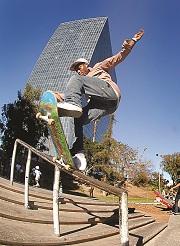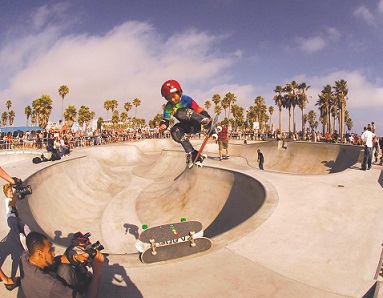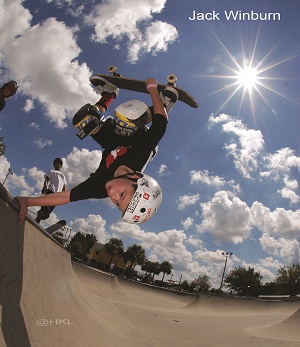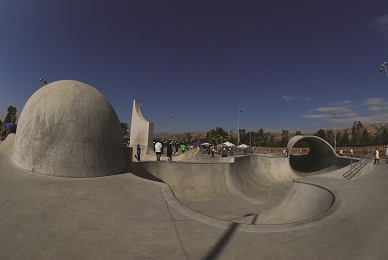
 |
| Photo by Ed Uthman, originally printed in Wikipedia |
Some sports are easy to categorize. Field sports -- soccer, field hockey, football, lacrosse, rugby and more -- are discernible by the surface they're played on. Racquet sports -- tennis, racquetball, squash and badminton -- are defined by the equipment players use.
Then there are sports that are almost impossible to pigeonhole. And one of the all-time great examples is adventure sports. They're variously known as action sports, freestyle sports, freesports and extreme sports. They take place on all surfaces -- snow, ice, dirt, water, tracks, roads and more -- and are linked only by the perception of danger, or at least physical risk, assumed by the athlete. They tend to skew younger in participants, and they're generally solitary pursuits, rather than team sports. They also have a strong spectator following. A few are showcased at events such as the X Games or Dew Tour.
A quick sampling of the many adventure sports includes cave diving, windsurfing, bungee jumping and street luge. The common denominator? Athletes who like not just to push the envelope, but lick the stamp. Closer to home, and more importantly for the sports tourism market, however, there is a sector of adventure sports that can be hosted in many cities: skate park events.
 As more cities and private concerns build skate parks to provide recreational opportunities for youth, there has been a corresponding increase in the number of competitive and demonstration events held in and around these facilities. Some events may last one afternoon and be of interest mainly to local residents, while others are multi-day events, drawing intense media coverage and attracting national, and even international talent.
As more cities and private concerns build skate parks to provide recreational opportunities for youth, there has been a corresponding increase in the number of competitive and demonstration events held in and around these facilities. Some events may last one afternoon and be of interest mainly to local residents, while others are multi-day events, drawing intense media coverage and attracting national, and even international talent.
Heidi Lemmon, executive director of Skate Park Association International, is one of the authorities on these events. Want to establish your area as a place to host skate park events and similar activities? Read on.
Sports Destination Management: Skate-specific venues are referred to as parks and plazas. What is the difference?
Heidi Lemmon: A skate plaza has features that look like part of the terrain you would find in an urban area: sidewalks, open areas and so forth. Plazas are awesome and will be occupied almost entirely by 12-22 year old male skaters. A full skate park, however, has features like bowls, a snake run and a plaza area. The bowls bring in the girls, older men and kids. They are family-friendly and better for overall competition.
SDM: Is one type of facility preferable for events?
 HL: It depends on the kind of event you want to host. If someone is planning a street skating contest, a plaza would be fine to use. If they're planning to host an event that includes a bowl contest, you want to get a park. There are some amazing facilities out there -- some parks can be up to 68,000 square feet, and they have flat areas for beginners to use.
HL: It depends on the kind of event you want to host. If someone is planning a street skating contest, a plaza would be fine to use. If they're planning to host an event that includes a bowl contest, you want to get a park. There are some amazing facilities out there -- some parks can be up to 68,000 square feet, and they have flat areas for beginners to use.
SDM: The demand for skate facilities appears to be growing. What are the drivers in this?
HL: Here in California, use is really dominated by the skateboard industry, but now we're also seeing BMX riders, inline skaters and even scooters in parks and plazas nationwide. Scooters, in particular, have come out of nowhere, and they're a huge part of the crowd now. In fact, some of the parks are being overcrowded with them, and cities have been caught with their pants down, so to speak. Their parks aren't big enough to handle the crowd of skateboarders as it is. We're learning that cities need more parks, and they need bigger parks to accommodate everyone.
Editor's Note: The association's website (www.spausa.org) includes a section dedicated to the importance of allowing other users, such as BMX riders, into skate parks; this section includes information that other usage does not damage the skating surface, and should be encouraged, as it provides individuals a healthy and constructive opportunity for recreation.
SDM: What trends are you seeing, along with the increase in, and diversity of, skate facility use?
 HL: The big trend right now is downhill racing, which means people racing on the streets. But you can't just say 'We're going to use this street.' In addition to having the road closed off to traffic for the event, you have to be very careful about the surface. You need to make sure it's smooth and able to be skated on. That means clearing off any gravel, leaves or anything else that could throw someone off balance when they're moving fast. You need your athletes to stay safe.
HL: The big trend right now is downhill racing, which means people racing on the streets. But you can't just say 'We're going to use this street.' In addition to having the road closed off to traffic for the event, you have to be very careful about the surface. You need to make sure it's smooth and able to be skated on. That means clearing off any gravel, leaves or anything else that could throw someone off balance when they're moving fast. You need your athletes to stay safe.
SDM: What other considerations are there?
HL: You need to take care of your spectators' safety too. For example, if you're hosting an event at a skate plaza or skate park, you want to make sure spectators know where they can be, where they can sit, where they can safely walk and so on. You want netting to protect people if a board or something gets loose. The same thing applies to a downhill race; you may need barricades to keep people off the course.
Something a lot of people don't realize is that the highest area of risk is actually during setup, not during the actual skating. If you have people setting up scaffolding, bleachers, etc., you want to make sure those people are insured. In fact, in almost every case we have heard about where there has been an injury, it has involved people working with scaffolding.
 SDM: How hard is it to get insurance for an event?
SDM: How hard is it to get insurance for an event?
HL: Not as hard as it used to be! One of the things our organization offers is insurance. When we founded the association in 1996, there were only one or two public parks in the U.S. and a handful of private parks. The private ones were really struggling with high insurance premiums. As we organized and built up members, we kept hearing them say insurance was a problem. We finally found someone who would put together an insurance program for us. This has allowed people to afford to build and operate more parks.
Most city skate park policies do not cover competitions. We can offer special daily rates for people putting on events, demos and contests, as well as for downhill racing. Coverage can include athletes and spectators. If people are interested, we can provide information on getting coverage for camps, leagues, instruction and other things.
SDM: If a planner is looking for a location for a skate event, how should they do their research?
HL: First of all, look for a good park. A lot of places can look good on paper or on the Internet, but aren't good in real life, so get feedback from other skaters. There are several web sites that can help you with this. Also, find out if there are hotels or motels close by, and if they are affordable, and convenient to the park. If you're talking about a young crowd, they'll need something in their price range. Finally, you want a community that is skater-friendly, that welcomes the event and is excited about it.
